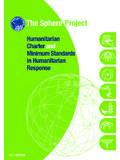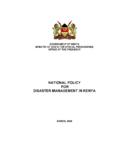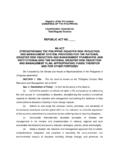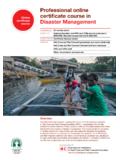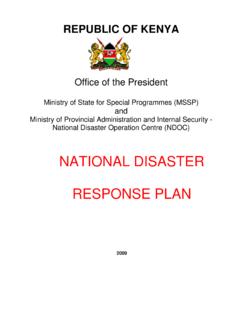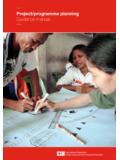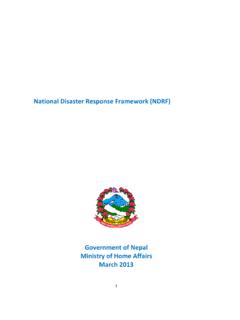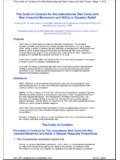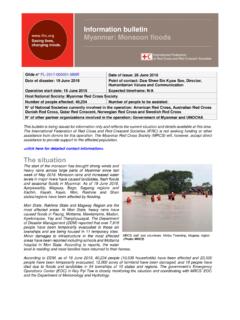Transcription of How to conduct a food security assessment - IFRC.org
1 How toconduct afood securityassessmentA step-by-step guide forNational Societies in Africa2006 Second edition (1st edition December 2005)International Federation of Red Cross and Red Crescent Box 372CH-1211 Geneva 19 SwitzerlandTelephone: +41 22 730 4222 Telefax: +41 22 733 0395E-mail: site: International Federation of Red Cross and Red Crescent SocietiesAny part of this handbook may be cited, copied, translated into other languages or adapted to meet local needs withoutprior permission from the International Federation of Red Cross and Red Crescent Societies, provided that the source isclearly photo: International Federation of Red Cross and Red Crescent source: DoF/NACA-STREAM/FAO Workshop on Livelihoods Approaches and Analysis. Yangon, Myanmar and acronyms _____5 Who is this guide for? _____5 When to use this guide _____5 How to use this guide is food security ? is an assessment ? is a food security assessment ?
2 _____15 What is the objective of a food security assessment ? _____15 When to conduct a food security assessment _____16 The main principles of a food security assessment _____17 The different phases of a food security assessment _____18 Possible responses to food insecurity to conduct a food security assessment _____21 Step 1: Preparation phase of food security assessment _____21 How to prepare a food security assessment _____21 How to define food security assessment objectives _____23 Step 2: Phase of secondary information collection _____25 Step 3: Phase of primary information collection _____27 How to collect information through observation_____28 How to collect information through interviews_____29 What are interviews? _____29 Who should you interview? _____30 How to select the people you want to interview _____32 How to conduct an interview _____34 Information to collect during interviews _____35 Interview checklist: what to ask _____37 Step 4.
3 Analysis to compile a food security assessment report Federation of Red Cross and Red Crescent to do a mid-upper-arm circumference (MUAC) measurement _____ of terms of reference _____ to do mapping _____ to make a seasonal calendar _____ to do proportional piling _____ to do pair-wise ranking and year ranking _____ to compile a timeline _____ to compile an activity profile _____ to compile a price overview table _____ 70 FAOFood and Agriculture OrganizationFEWSF amine early warning systemFSFood securityICRCI nternational Committee of the Red CrossInternationalFederationInternationa l Federation of Red Cross and Red Crescent SocietiesMUACMid-upper-arm circumferenceNGONon-governmental organizationPLWHAP eople living with HIV/AIDSUNU nited NationsUNHCRU nited Nations High Commissioner for RefugeesUNICEFU nited Nations Children s FundUNOCHAU nited Nations Office for Coordination of Humanitarian AffairsWFPW orld food ProgrammeWHOW orld Health Organization3 Abbreviationsand acronymsAbbreviations and acronyms4 Yoshi Shimizu/International
4 Federation11 Who is this guide for?In 2003 the International Federation of Red Crossand Red Crescent Societies adopted the Policy onFood security and Nutritionin which it encouragedNational Societies to conduct food security assess-ments. This guide is intended for National Societystaff and volunteers in Africa who want to under-take food security assessments, but have no back-ground knowledge on food security or to use this guideA food security assessment may be required when living conditions in an area/country change, andit is expected that communities are becoming vulnerable and/or are no longer able to meet theirnutritional needs. This can arise prior to or during a sudden hazard or when generally the situationbecomes alarming slowly but consistently; including in case of drought, floods, locust infestation,outbreak of conflict/war, influx of refugees and the HIV/AIDS to use this guideThis guide should be used as a practical tool to undertake an initial food security assessment .
5 It goesthrough the different stages of a food security assessment , and provides techniques and examples ofhow to perform a food security assessment . The guide can be used both in rural or urban this guide you will see boxes with definitions relating to food assessments and tips forconducting food assessments. Much of the information in these boxes is drawn from documents list-ed in the References section of this guide. The reference number in the box relates to the documentin the References section with the same number. If you would like to do further reading on food assessments, these references are an excellent sourceof additional information. Also, the International Federation would like to credit and thank theseand other organizations for making the information available to the wider aid relevant food security and assessment materials are developed by the International Federationand available for use: food security training modules.
6 International Federation, 2006. Guidelines for Emergency assessment . International Federation, 2005. food security case studies. International Federation, 2003 and 2004. Project Planning Process handbook. International Federation, 2002. Better Programming Initiative, options to improve the impact of programmes. International Federation, 2002. Disaster Preparedness training manual. International Federation, 2001. Vulnerability and Capacity assessment , an International Federation guide. International Federation, Federation 2003 Policy on food security and Nutrition*The International Federation and each National Society shallundertake food security assessment and analysis that demon-strates an understanding of how affected populations nor-mally secure food , the risks, the causesand impactof disas-ters on the immediate and future food security and the mostappropriate responses to address both transient (acute) foodinsecurity and longer-term (chronic) food insecurity, throughrecognizing and supporting household coping mechanisms.
7 *Adopted by the 8th Session of the Governing Board in Geneva, 21-23 October 2003 (reference 6)IntroductionIntroduction6 International Federation22 The definition of food security is based on three important pillars: food availability; food access; and food availability in a country, region or local area meansthat food is physically present because it has been grown,manufactured, imported and/or transported there. Forexample: food is available because it can be found on mar-kets, because it is produced on local farms, land or homegardens, or because it arrives as part of food aid, etc. This isfood that is visible and in the area. food accessis the way different people can obtain the available food . Normally we access foodthrough a combination of home production, stocks, purchase, barter, gifts, borrowing or food access is ensured when communities and households and all individuals within them have ade-quate resources, such as money, to obtain appropriate foods for a nutritious diet.
8 Access depends onincome available to the household, on the distribution of income within the household and on theprice of food . It also depends on market, social and institutional entitlement/rights to which indi-viduals have access can be negatively influenced by physical insecurity such as conflict, loss of copingoptions, such as border closure preventing seasonal job migration, or the collapse of safety net insti-tutions that once protected people with low utilizationis the way people use the food and is dependent on the quality of the food , itspreparation and storage method, nutritional knowledge, as well as on the health status of the indi-vidual consuming the food . Certain diseases do not allow for the maximum absorption of nutrientsand growth requires increased intake of certain utilization is often reduced by endemic disease, poor sanitation, lack of appropriate nutritionknowledge or culturally prescribed taboos that affect access to nutritious food by certain groups orfamily members according to age or gender.
9 Any of the above-mentioned factors can cause food insecurity. 7 What is food security ? food securityA person, household or community, region ornation is food securewhen all members at alltimes have physical and economic access to buy,produce, obtain or consume sufficient, safe andnutritious food to meet their dietary needs andfood preferences for a healthy and active life. DefinitionWhat is food security ? food insecurityVulnerability to household food inse-curity is the combined effect of thefollowing three components: Underlying vulnerabilities of acommunity;this cannot bechanged by the individual andrelates to factors including cli-mate and poverty. The external hazards affectingthe community over which theyhave no control, includingdrought, flood and politicalupheaval. The internal capacity of thehousehold/community to copewith a situation of food insecuri-ty; this is related to a household sor community s resources, skillsand networks that allows them toovercome a difficult internal capacity is present inallhouseholds.
10 Some households may be able to cope with some hazards better than households may be consistently exposed to hazards or face long-lasting disease in thefamily and therefore lose their capacity to cope, over time. 8 International Federation of Red Cross and Red Crescent SocietiesVulnerabilityVulnerability says something about the level of riskfor households or communities concerning threats totheir lives and livelihood*. A household s vulnerability is determined by the abil-ity of a household to cope with risks and shockssuch asdrought, flooding, government policies, conflict, andthe HIV/AIDS crisis. The magnitude, duration andtiming of the shock are important factors. In order to avoid the most severe impacts of shocksand maintain adequate food access, households andcommunities employ coping strategies. Vulnerability is not the same as poverty, althoughunderlying poverty contributes to increased vulnera-bility in most emergencies; the effects of disasters aremade worse where they are superimposed on a situa-tion of widespread structural poverty.
